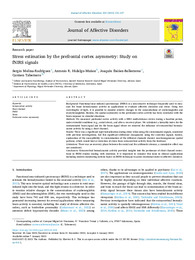Please use this identifier to cite or link to this item:
https://hdl.handle.net/11000/30632
Stress estimation by the prefrontal cortex asymmetry: Study on fNIRS signals
Title:
Stress estimation by the prefrontal cortex asymmetry: Study on fNIRS signals |
Authors:
Molina Rodríguez, Sergio
Hidalgo Muñoz, Antonio R.
Ibáñez Ballesteros, Joaquín
Tabernero, Carmen |
Department:
Instituto de Neurociencias
Departamentos de la UMH::Fisiología |
Issue Date:
2023-03-15 |
URI:
https://hdl.handle.net/11000/30632 |
Abstract:
sure
the brain hemodynamic activity in applications to evaluate affective disorders and stress. Using two
wavelengths of light, it is possible to monitor relative changes in the concentrations of oxyhemoglobin and
deoxyhemoglobin. Besides, the spatial asymmetry in the prefrontal cortex activity has been correlated with the
brain response to stressful situations.
Methods: We measured prefrontal cortex activity with a NIRS multi-distance device during a baseline period,
under stressful conditions (e.g., social stress), and after a recovery phase. We calculated a laterality index for the
contaminated brain signal and for the brain signal where we removed the influence of extracerebral hemodynamic
activity by using a short channel.
Results: There was a significant right lateralization during stress when using the contaminated signals, consistent
with previous investigations, but this significant difference disappeared using the corrected signals. Indeed,
exploration of the susceptibility to contamination of the different channels showed non-homogeneous spatial
patterns, which would hint at detection of stress from extracerebral activity from the forehead.
Limitations: There was no recovery phase between the social and the arithmetic stressor, a cumulative effect was
not considered.
Conclusions: Extracerebral hemodynamic activity provided insights into the pertinence of short channel corrections
in fNIRS studies dealing with emotions. It is important to consider this issue in clinical applications
including modern monitoring systems based on fNIRS technique to assess emotional states in affective disorders.
|
Keywords/Subjects:
Extracerebral activity
Short channel
fNIRS
Stress
Prefrontal cortex asymmetry |
Type of document:
application/pdf |
Access rights:
info:eu-repo/semantics/openAccess
Attribution-NonCommercial-NoDerivatives 4.0 Internacional |
DOI:
https://doi.org/10.1016/j.jad.2023.01.018 |
Appears in Collections:
Artículos Fisiología
|
 ???jsp.display-item.text9???
???jsp.display-item.text9???

.png)
